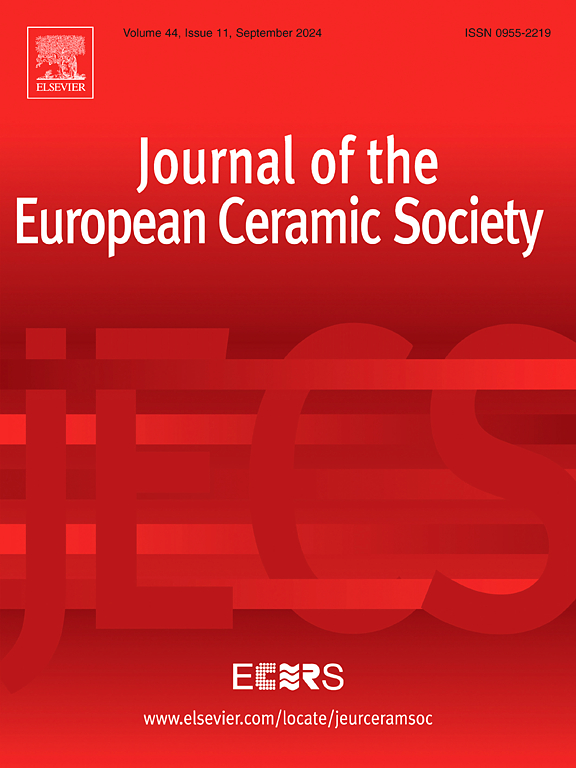Exploring the dielectric properties, glass ability and ferroelectric phases in the BaO-Bi2O3-TiO2-B2O3-Al2O3 system
IF 5.8
2区 材料科学
Q1 MATERIALS SCIENCE, CERAMICS
Journal of The European Ceramic Society
Pub Date : 2025-05-12
DOI:10.1016/j.jeurceramsoc.2025.117527
引用次数: 0
Abstract
In this study, Bi- and Ti-rich glasses have been designed and investigated for the development of ferroelectric glass-ceramics (GCs). The glass formation range, the structure of the glass network and the crystalline phases obtained in the glass-ceramics were explored. Glass compositions within the xBaO-(90-x)(40Bi2O3-25TiO2-35B2O3)-10Al2O3 system were synthesized through rapid press quenching of the melt, with a controlled melting temperature of 1000°C. Raman spectroscopy was carried out to investigate the impact of Bi2O3, TiO2 and BaO on the arrangement of the structural units in these glasses. Subsequent thermal treatment in the temperature range of 500–700°C led to the formation of glass-ceramics containing the ferroelectric Bi4Ti3O12 crystal phase in all compositions. Notably, glass-ceramics containing 10–16 mol% of BaO exhibited a single Bi4Ti3O12 crystal phase upon complete crystallization. The microstructure and temperature-dependent dielectric properties of glasses and GCs were investigated as a function of the Ba content. The permittivity εr of the glasses is quite high compared to other glass systems, ranging between 22 and 28, and it is greatly increased in the crystallized samples (up to 70). Furthermore, no phase transitions up to 300 °C are observed, especially in GCs with a single Bi4Ti3O12 crystal phase, making these materials strong candidates for energy storage dielectrics. The samples developed in this study demonstrate the potentiality of obtaining piezoelectric glass-ceramics in network former-poor matrices.
探索BaO-Bi2O3-TiO2-B2O3-Al2O3体系的介电性能、玻璃化性能和铁电相
在这项研究中,设计和研究了富铋和富钛玻璃,用于铁电玻璃陶瓷(GCs)的发展。探讨了微晶玻璃的形成范围、玻璃网的结构和所得到的晶相。通过对熔体进行快速压淬,控制熔体温度为1000℃,合成了xBaO-(90-x)(40Bi2O3-25TiO2-35B2O3)- 10al2o3体系中的玻璃成分。利用拉曼光谱研究了Bi2O3、TiO2和BaO对玻璃中结构单元排列的影响。随后在500-700℃的温度范围内进行热处理,形成了含有铁电Bi4Ti3O12晶相的微晶玻璃。值得注意的是,含有10-16 mol% BaO的微晶玻璃在完全结晶后表现出单一的Bi4Ti3O12晶相。研究了Ba含量对玻璃和gc的显微结构和介电性能的影响。与其它玻璃体系相比,该玻璃的介电常数εr较高,介电常数εr在22 ~ 28之间,结晶样品的介电常数εr大大增加(可达70)。此外,没有观察到高达300°C的相变,特别是在具有单一Bi4Ti3O12晶体相的gc中,使这些材料成为储能电介质的强有力候选材料。本研究中开发的样品证明了在网络前差矩阵中获得压电玻璃陶瓷的潜力。
本文章由计算机程序翻译,如有差异,请以英文原文为准。
求助全文
约1分钟内获得全文
求助全文
来源期刊

Journal of The European Ceramic Society
工程技术-材料科学:硅酸盐
CiteScore
10.70
自引率
12.30%
发文量
863
审稿时长
35 days
期刊介绍:
The Journal of the European Ceramic Society publishes the results of original research and reviews relating to ceramic materials. Papers of either an experimental or theoretical character will be welcomed on a fully international basis. The emphasis is on novel generic science concerning the relationships between processing, microstructure and properties of polycrystalline ceramics consolidated at high temperature. Papers may relate to any of the conventional categories of ceramic: structural, functional, traditional or composite. The central objective is to sustain a high standard of research quality by means of appropriate reviewing procedures.
 求助内容:
求助内容: 应助结果提醒方式:
应助结果提醒方式:


